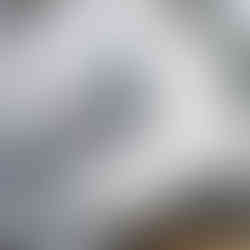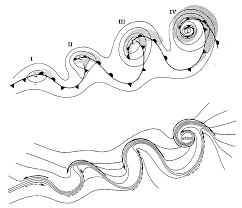Cyclogenesis: An Earthwork by Adrien Segal
- Mary Modeen
.jpg/v1/fill/w_320,h_320/file.jpg)
- Nov 1, 2022
- 6 min read

“Environments are constituted in life, not just in thought, and it is only because we live in an environment that we can think at all.”
-Tim Ingold, The Perception of the Environment: Essays on livelihood, dwelling, and skill

My creative process often begins with a highly personal experience in the landscape. I arrived in Scotland for the first time in January of 2022, and the impression that struck me about the landscape was the wind. I heard there had very recently been two intense storms, with extreme wind gusts that had leveled large areas of forested land in the preceding months. Observing natural phenomena present in the environment is at the heart of my artistic focus, particularly looking towards processes, cycles, seasonal rhythms, and natural forces that change landscapes over time - either gradually over geologic timescales, or in a single impactful event. Often, a time scale becomes one, if not two, of the dimensions of my site-specific sculptural artworks that reveal unseen forces at play in the surrounding landscape.
Material knowledge was the focus of my research proposal, or more specifically, an exploration into the ways in which knowledge can be translated across time through physical objects. This proposal brought me to Dundee for six months as the US-UK Fulbright Scholar at the University of Dundee. My previously established art practice for the past two decades has involved translating scientific data into physical forms and materials to reveal the information as tangible and tactile objects, or sculptures, that can be experienced by the body in a completely different way than how one might read a chart or a numeric table. This fairly recent, niche field is sometimes referred to as “data physicalization”. I specifically came to Scotland for the rich history of traditional craft practices, the expansive collection of archaeological artifacts, and its philosophical position as the epicenter of the Enlightenment, where the seeming opposition between reason and passion have long been debated by the likes of David Hume.
“Reason is, and ought only to be the slave of the passions, and can never pretend to any other office than to serve and obey them.” - David Hume
Responding to the surrounding environment led my research on a circuitous path of inquiry, in which the earthwork Cyclogenesis was ultimately born. In seeking a source for local materials to turn into sculpture, I was introduced to Kevin Frediani, the Curator of the University of Dundee Botanical Garden. Touring the grounds, I saw the impact of the storms on the landscape. Forty-five trees had been damaged or taken down by winter Storms Arwen and Barra, Nov 25-27 and Dec 5-9, 2021 at the Garden, and tens of thousands of trees had been felled across Scotland (“Storm Arwen”). Passing through the area where a grouping of eucalyptus trees were felled by these two extratropical storms, I mentioned the idea to transform the area into an earthwork that commemorates and memorializes the natural phenomena that changed the area so drastically in an extraordinary weather event.
^ Storm Barra viewed from space (NASA), Storm damaged tree at the Dundee Botanical Garden (Image by the Artist), Downed trees in the aftermath of Storm Arwen (Need permission, Source Forestry and Land Scotland)

“The damage caused by the storm was compounded by the fact that "sustained winds with gusts in excess of 90 mph were, unusually, from the north-east, affecting trees that do not normally have to yield to those winds." (Graham)
It was fortuitous that I met with Dr David A. Hooper to discuss extratropical storms on February 18, 2022 - the same day a Red Weather warning had been issued across the UK with expected landfall of Storm Eunice. My conversation with Dr Hooper, an Instrument Scientist at the Atmospheric Measurement and Observation Facility at Capel Dewi Atmospheric Observatory (CDAO) in west Wales, lead to further exchanges about the Sting Jet phenomenon with Dr Graham Parton with the National Centre for Atmospheric Science. Their guidance brought about the inspiration to create a large-scale earthwork based on a diagram of the four states of development of an extratropical cyclone, also known as “Cyclogenesis”.
^ Sting Jet Model (EUME Train /Permission needed). ^An alternative model of frontal-cyclone evolution (Shapiro and Keyser).
“A sting jet is a meteorological phenomenon which has been postulated to cause some of the most damaging winds in extratropical cyclones.” (Wikipedia)
“Cyclogenesis is the development or strengthening of cyclonic circulation in the atmosphere. Extratropical cyclones form as waves along weather fronts before occluding later in their life cycle as cold core cyclones.” (Wikipedia)
Manifested from materials at hand, including the felled eucalyptus trees, the artwork provides a physical space for visitors to experience cyclonic patterns and movements by walking through and around the earthwork. Kevin Frediani the Curator at the Botanic Garden said, “this may be one of the most creative outcomes from Storm Arwen, as Adrien Segal has worked with our garden technician Trevor Whyte to create land art in the wake of the storm that wrought damage to University of Dundee Botanic Gardens living collections. A visual reminder that becoming resilient is not to wipe away the evidence of climate change but to develop the capacity to recover quickly from the difficulties & adapt to the emerging state!”
In addition to the earthwork - which is intended to evolve with the seasonal changes in the natural environment over time - a related installation of small scale sculptural experimentations in clay, wax, bronze, ceramic shell, wicker, mulberry wood, soil, found objects, and other natural materials, all created during her Fulbright fellowship at DJCAD, was on view in the Living Lab during the opening on July 21, 2022. The installation includes a ceramic model of the earthwork, a wicker basket base made in collaboration with traditional basket maker Rachel Bower, bronze cast spheres surface etched with a pattern of Coriolis Forces in global weather movements and inspired by the Carved Stone Balls found across Scotland (Marshall), are collectively installed surrounded by soil from which the earthwork is made.

“Organisms, in coordination with dynamic physical processes, have developed considerable influence on the earth’s planetary environment…. It is the ability of organisms to live on energy flows from the sun and to sort materials that makes the earth a pocket of negative entropy.”
- Howard Mielke, Patterns of Life
“Land art is in large measure about the landscape itself—its scale, its vistas, its essentially horizontal character, its topography, and its human and natural history.”
- John Beardsley, Earthworks and Beyond

^ Installation with basketry and other artifacts, Cyclogenesis model in ceramic, wood carving in Mulberry wood harvested from the Botanical Garden, Cast bronze ball based on Coriolis Force in Earth’s weather patterns. (Images Courtesy of the Artist).
Adrien Segal is an artist based in Oakland, California. Drawing from landscape, science, history, emotion, and perception, her interdisciplinary work bridges the gap between scientific rationality and the emotional nature of human experience. Her work has been exhibited internationally since 2007 and is published in several books and journals. She has been awarded Artist Residencies across the US, Canada, and Europe. In 2022 Adrien was the US-UK Fulbright Scholar at the University of Dundee in Scotland. In addition to teaching, she pursues her creative practice out of her studio workshop in Alameda, California. Her work can be seen at www.adriensegal.com.
Cyclogenesis: An Earthwork was created in partnership with US-UK Fulbright Scholar Adrien Segal and the University of Dundee Botanical Garden, with guidance from Dr Graham Parton and Dr David A. Hooper, scientists with the National Centre for Atmospheric Science.
Works Cited / Further Reading
Beardsley, John. Earthworks and Beyond. New York ; London, Abbeville Press, 1998.
“Cyclogenesis.” Resources.eumetrain.org, 2020, resources.eumetrain.org/data/5/569/navmenu.php?tab=4&page=1.0.0. Accessed 12 Sept. 2022.
“Cyclogenesis.” Wikipedia, 6 Sept. 2021, en.wikipedia.org/wiki/Cyclogenesis. Accessed 10 Sept. 2022.
Ingold, Tim. The Perception of the Environment : Essays on Livelihood, Dwelling and Skill. London ; New York, Routledge, Taylor & Francis Group, 2000.
Dewey, John. Experience and Nature. Editorial: New York, Dover Publications, 2018.
“Data Physicalization - Data Physicalization Wiki.” Dataphys.org, 23 Aug. 2017, dataphys.org/. Accessed 12 Sept. 2022.
Graham, August. “Storm Arwen Power Cuts “Made Worse by Wind from Unusual Direction.”” Evening Standard, 7 Dec. 2021, www.standard.co.uk/news/uk/boris-johnson-mps-met-office-graham-b970442.html. Accessed 10 Sept. 2022.
Marshall, Dorothy. “Carved Stone Balls.” Proceedings of the Society of Antiquaries of Scotland, vol. 108, 1979, pp. 40–72, soas.is.ed.ac.uk/index.php/psas/article/view/8959. Accessed 10 Sept. 2022.
Mielke, Howard W. Patterns of Life : Biogeography of a Changing World. Springer, 1989.
Sandie, Colin. “Storm Arwen: The Aftermath.” Forestry and Land Scotland, 21 Dec. 2021, forestryandland.gov.scot/blog/storm-arwen-aftermath. Accessed 10 Sept. 2022.
Shapiro, M.A. and Keyser, D. On the structure and dynamics of fronts, jet streams and the tropopause. Extratropical Cyclones: The Erik Palmén Memorial Volume, C. W. Newton and E. O. Holopainen, Eds., Amer. Meteor. Soc. 1990. pp.167-191.
Squier, E. G., and E. H. Davis. Ancient Monuments of the Mississippi Valley : Comprising the Results of Extensive Original Survey and Explorations. New York, Cincinnati, Bartlett & Welford ; J.A. & U.P. James, 1848.
“Storm Arwen: Tens of Thousands of Trees Toppled and Dangerous.” BBC News, 30 Nov. 2021, www.bbc.com/news/uk-england-59481440. Accessed 12 Sept. 2022.

















Comments